theartsdesk at the Two Moors Festival - birdsong, gongs and nocturnes in Dartmoor churches | reviews, news & interviews
theartsdesk at the Two Moors Festival - birdsong, gongs and nocturnes in Dartmoor churches
theartsdesk at the Two Moors Festival - birdsong, gongs and nocturnes in Dartmoor churches
In tune with the natural wonders of Devon's high places, musicians excel
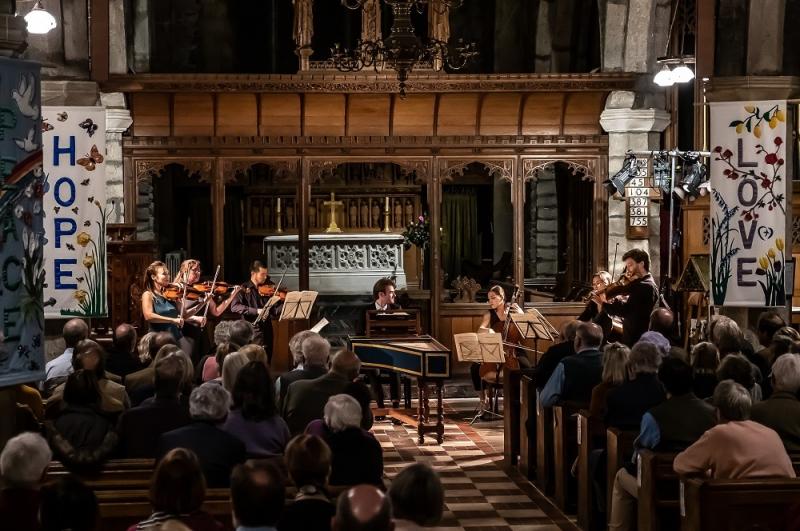
First came the difficult decision: whether to experience performances by great musicians whose work I already knew in the second, Exmoor-based weekend of the Two Moors Festival, or to go for enticing programmes by others whom I’d never experienced live around Dartmoor.
Three cheers for the festival’s artistic director, top violinist Tamsin Waley-Cohen. In all the best festivals, the most communicative musicians always find each other, and the connections forged here in terms not only of people but also of programming went well beyond the exploration of nature implied in the banner “Arcadia Unlocked”; the fluidity of subterranean links between each concert had the kind of clairvoyant skill previously to be sensed in Svend Brown’s East Neuk Festival. 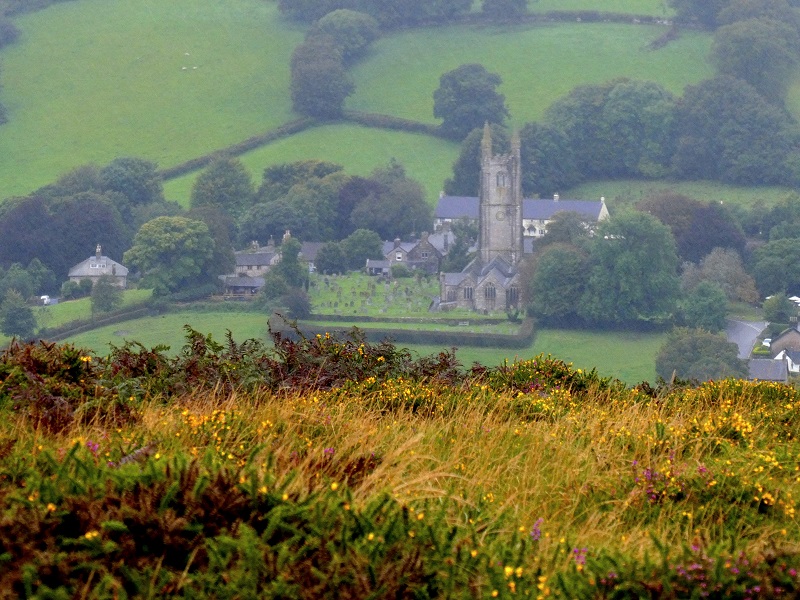
Part of the magic was feeling out of the busy world, after the previous night’s Royal Festival Hall concert of 134 Philharmonia players, in the company of two consummate musicians who drew you into their conversations – soprano Ruby Hughes and theorbist Sergio Bucheli (pictured below) There was an instrumental intimacy on the cusp of silence which I’ve only previously experienced from the middle eastern oud, while Hughes inflected Robert Johnson’s setting of Fletcher’s “Care charming sleep” with perfect tone colours on the words “sweetly thyself dispose” and “silver rain”.  Of the Dowland selection, punctuated by folk-based theorbo solos, “Go crystal tears” was perfection. And the surprise coda, Errollyn Wallen’s “Peace on Earth”, hypnotised in its simple originality and dying falls: a miniature masterpiece looking ahead to Christmas. Spoken introductions and a neat account of the theorbo’s history enriched the occasion – such talks were features of all bar one of the concerts to follow, so credit to Waley-Cohen for encouraging them – and the acoustics of cosy St Pancras proved warm but never over-resonant.
Of the Dowland selection, punctuated by folk-based theorbo solos, “Go crystal tears” was perfection. And the surprise coda, Errollyn Wallen’s “Peace on Earth”, hypnotised in its simple originality and dying falls: a miniature masterpiece looking ahead to Christmas. Spoken introductions and a neat account of the theorbo’s history enriched the occasion – such talks were features of all bar one of the concerts to follow, so credit to Waley-Cohen for encouraging them – and the acoustics of cosy St Pancras proved warm but never over-resonant.
It must have been the venue and maybe the platform below her which made Cordelia Williams (pictured below) change her mind about the Steinway on loan from the Dorset Music Society, which she hadn’t enjoyed playing in a previous recital. This, she said afterwards, felt completely different. Her late-evening concert took us from moonlight in Scriabin’s Second Piano Sonata, its first-movement silences magically integrated, through a twofold meditation through the hour of the wolf to Schumann’s Songs of Dawn and the pearly morning light and at-one-with-the-worldness of Schubert’s happiest sonata, the A major D664. 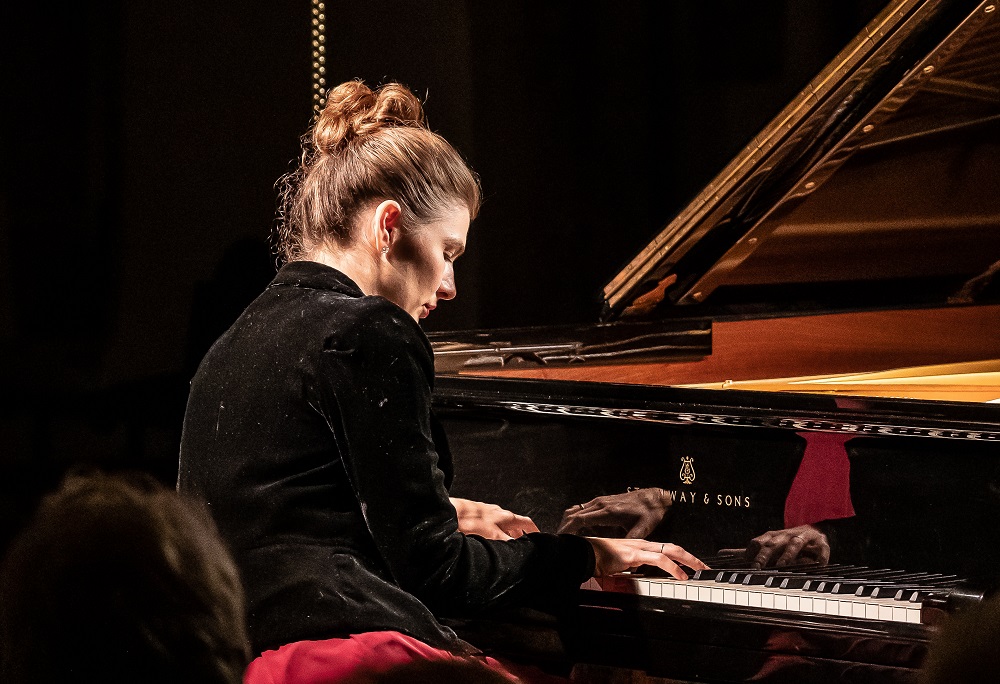 The linked reflection for the hours before the dawn was the most surprising: Williams said she felt a deep affinity between Thomas Tomkins’ A Sad Pavan for these Destructive Times and Bill Evans’ Peace Piece, seeming improvisations upon a gentle ostinato bass. For me, the revelation was the Schumann, so surprising in its modulations and subtle shifts of mood. Williams’ unshakeable evenness is a wonder, though I’ve heard more giving, ethereal approaches to the lovely melody that begins the Schubert Sonata.
The linked reflection for the hours before the dawn was the most surprising: Williams said she felt a deep affinity between Thomas Tomkins’ A Sad Pavan for these Destructive Times and Bill Evans’ Peace Piece, seeming improvisations upon a gentle ostinato bass. For me, the revelation was the Schumann, so surprising in its modulations and subtle shifts of mood. Williams’ unshakeable evenness is a wonder, though I’ve heard more giving, ethereal approaches to the lovely melody that begins the Schubert Sonata.
The birds of Dartmoor were very much up with the dawn of a rainy Sunday, restored to life after their late summer moulting, and a blackbird alarmed outside the Widecombe Church House where local artist and naturalist Tony Whitehead gave us a personable and succinct talk about avian song. I knew the why but not the how: did you know that the two tubes of the sound-box or syrinx allows the bird to make two sounds at once? I hadn’t thought about it or noticed it, but listening to the recordings I could hear the double effect – not exactly harmony – for the first time. 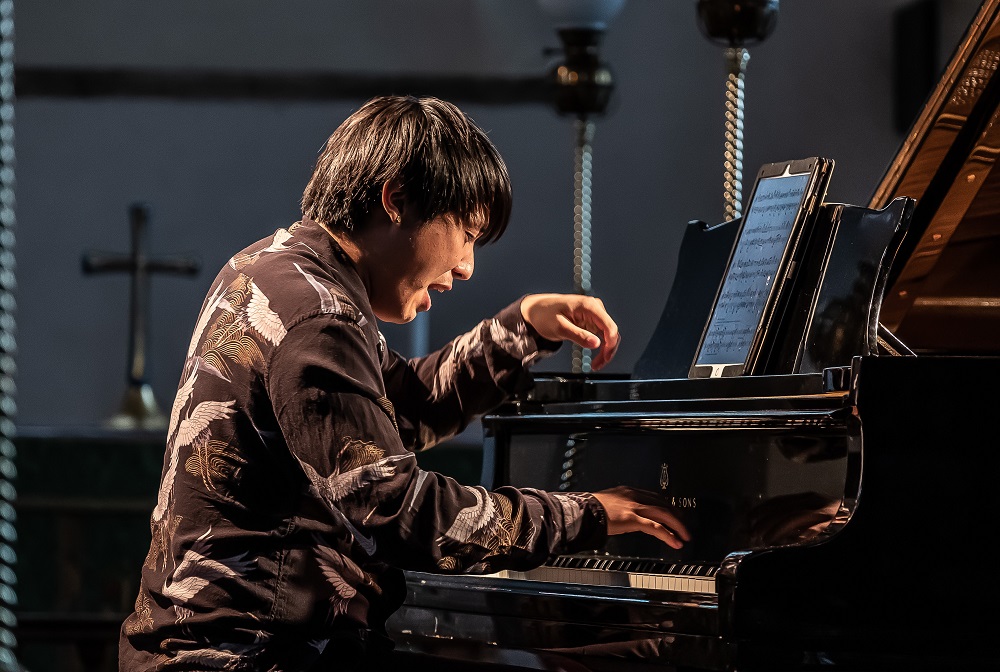 It certainly gave a kick to Messiaen’s steroidal fleshing out of single songs. And what a masterstroke from pianist George Xiaoyuan Fu (pictured above) to place three substantial tableaux from Catalogue d’Oiseaux between other bird-inspired pieces: the little mystery of Schumann’s "Bird as Prophet", Ravel’s "Oiseaux tristes" and the world premiere of three of Fu’s own startling paraphrases from Respighi’s The Birds, Messiaenizing Respighisation of Rameau, Pasquini and Gallot. This artist is a deep thinker, thoroughly in command of dynamics from pianissimo to fortissimo, and fearless in negotiating Messiaen’s more massive demands, the rock-faces between the poetic glidings, swoops and dives of birds of the French mountains, countryside and coastline. Another of Fu’s own transcriptions, a very forthright, scintillating treatment of Bach’s Gavotte en rondeau from the Third Partita for Violin, took us towards noon. But it’s clear from his Messiaen that Fu must emulate his mentor Pierre-Laurent Aimard’s Aldeburgh day of Catalogue d’Oiseaux, from dawn to midnight, in this venue and with Whitehead leading a dawn chorus walk before the first recital as well as taks about Messiaen's featured birds (he knows the music). Next May or the following one, please.
It certainly gave a kick to Messiaen’s steroidal fleshing out of single songs. And what a masterstroke from pianist George Xiaoyuan Fu (pictured above) to place three substantial tableaux from Catalogue d’Oiseaux between other bird-inspired pieces: the little mystery of Schumann’s "Bird as Prophet", Ravel’s "Oiseaux tristes" and the world premiere of three of Fu’s own startling paraphrases from Respighi’s The Birds, Messiaenizing Respighisation of Rameau, Pasquini and Gallot. This artist is a deep thinker, thoroughly in command of dynamics from pianissimo to fortissimo, and fearless in negotiating Messiaen’s more massive demands, the rock-faces between the poetic glidings, swoops and dives of birds of the French mountains, countryside and coastline. Another of Fu’s own transcriptions, a very forthright, scintillating treatment of Bach’s Gavotte en rondeau from the Third Partita for Violin, took us towards noon. But it’s clear from his Messiaen that Fu must emulate his mentor Pierre-Laurent Aimard’s Aldeburgh day of Catalogue d’Oiseaux, from dawn to midnight, in this venue and with Whitehead leading a dawn chorus walk before the first recital as well as taks about Messiaen's featured birds (he knows the music). Next May or the following one, please.
So to lunch at the first-rate Three Crowns in prosperous Chagford, and a concert in St Michael the Archangel, like all the other venues built of local stone, wagon-roofed, with startling medieval roof bosses sacred and profane, and handsomely screened before the chancel, though in this case a restoration had been responsible for the handsome work of the main screen if not the parcloses. Amarins Wierdsma, leader of the young Barbican String Quartet (pictured below), showed poetic imagination in the “sunrise” of Haydn’s Quartet in B flat major, Op. 76 No. 4, while maturity combined with wit in the lead back from the drone-bass trio of the Minuet. 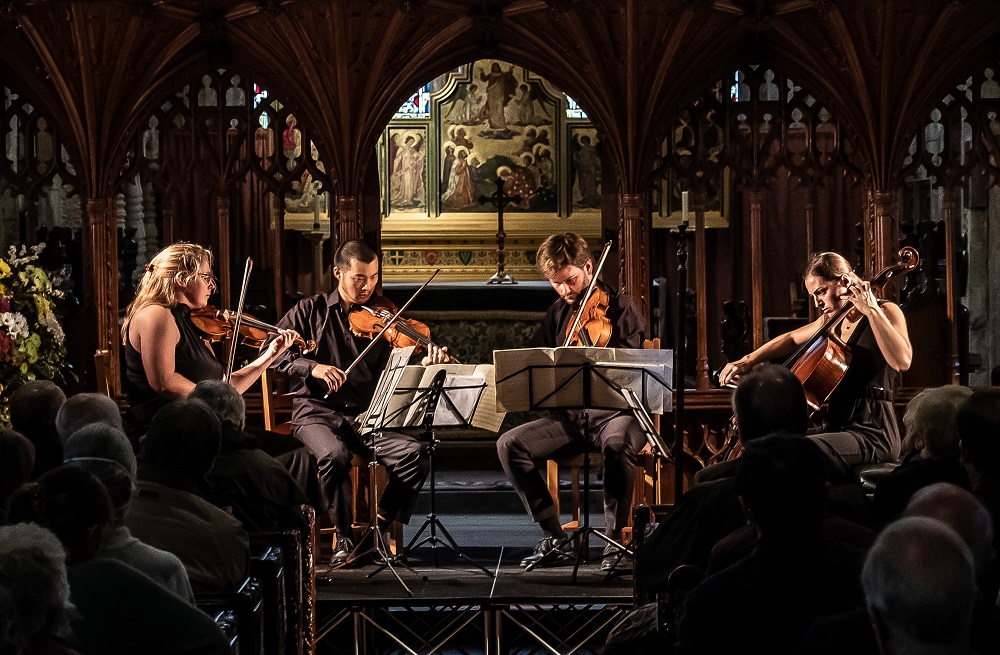 Schubert’s last quartet, the G major, D887, sounded fiercer than I’ve ever heard it, a painful battle with death, perhaps this composer’s most consistently anguished, with intense tremolos and searing, startlingly modern questions asked in the stormy episode of the Andante un poco moto. Schubert’s unique conflicts of major and minor have never sounded more extraordinary.
Schubert’s last quartet, the G major, D887, sounded fiercer than I’ve ever heard it, a painful battle with death, perhaps this composer’s most consistently anguished, with intense tremolos and searing, startlingly modern questions asked in the stormy episode of the Andante un poco moto. Schubert’s unique conflicts of major and minor have never sounded more extraordinary.
The Barbicans, if one may so call them, joined Waley-Cohen (pictured below), double-bass player Thea Sayer and harpsichordist Nathaniel Mander, for a Vivaldi Four Seasons in St Andrew’s Church, Ashburton – another one with a high tower (“inspiring,” declares Brian Watson in the Shell Guide to Devon). I hadn’t heard a live performance of this Classic FM favourite since a similar chamber version from the Razumovsky Ensemble led by Alexander Sitkovetsky back in 2009; now, as then, it struck me with its full vitality and range, not at all Des O’Connorish as Nigel Kennedy described it in a recent contretemps. 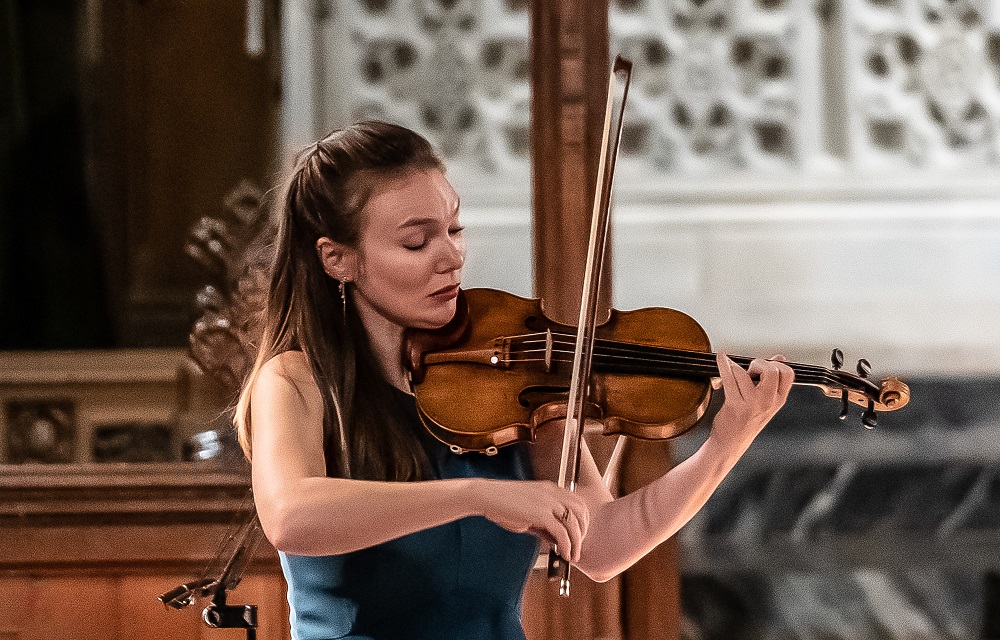 Waley-Cohen’s fierce fiddling was simply phenomenal, and all the more so following on the heels of the Bach Second Partita, an interpretation which gathered depth and interiority as it moved towards the great Chaconne. The introspective and the extrovert were brilliantly paired in a single event ecstatically received by the packed (but, alas, mostly maskless) audience. I’d have loved to stay and hear jazz singer Nishla Smith and pianist Tom Harris in the Ashburton Arts Centre, but we had a long drive back to our inn on the other side of Dartmoor.
Waley-Cohen’s fierce fiddling was simply phenomenal, and all the more so following on the heels of the Bach Second Partita, an interpretation which gathered depth and interiority as it moved towards the great Chaconne. The introspective and the extrovert were brilliantly paired in a single event ecstatically received by the packed (but, alas, mostly maskless) audience. I’d have loved to stay and hear jazz singer Nishla Smith and pianist Tom Harris in the Ashburton Arts Centre, but we had a long drive back to our inn on the other side of Dartmoor.
Sunday dawned bright and clear, good enough for a hike along the river Taw, Tarka the Otter territory, up to the high village of Belstone and back, though torrential rain soon set in. It was a day of rainbows and dramatic skyscapes. That was somehow complemented by the afternoon recital in St John the Baptist Hatherleigh by percussionist Joby Burgess (pictured below). Five strikingly different works, starting with the sheer poetry of Takemitsu’s Seasons, the Canna Sonora or Aluminium Harp at its core. Burgess, in his immensely likeable presentation, homaged the original interpreter, the phenomenal Stomu Yamash’tu, and praised the composers with whom he’d collaborated on the next three pieces. 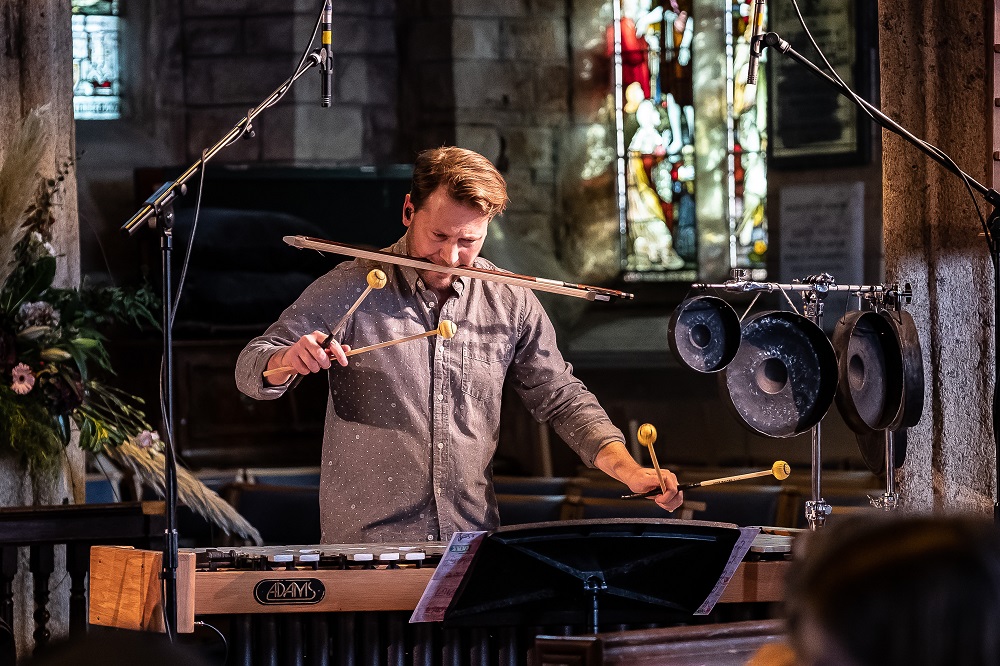 I loved the changes rung on the vibraphone and its loopings by Rebecca Dale in Can’t Sleep – a very different small-hours experience to the one Cordelia Williams had presented – and the fabulous theatre of riffs on a soda bottle, West African style, in Gabriel Prokofiev’s fabulous Fanta (the children in the audience were spellbound). Linda Buckley’s Ekstosis was new-age/minimal, but good for contrast, and the finale was the one we really should have been given earplugs for, John Luther Adams’ bass-drum solo evoking shamanic ritual in the Alaskan wilderness where he lived for decades, Qilyuan. Fingers half in ears didn’t preclude stunned appreciation of Talbot’s virtuosity across this quarter-hour stunner. As I left for the journey back to Exeter Station, balm wafted out from the school house where Stile Antico were rehearsing for the evening concert. A shame to miss that, but I’d had my visions. And now a longer immersion in Dartmoor nature beckons, thanks especially to the inspirations of Whitehead and fellow naturalist John Walters, who showed us wonders on film in Hatherleigh, in the shape of long walks from inn to inn.
I loved the changes rung on the vibraphone and its loopings by Rebecca Dale in Can’t Sleep – a very different small-hours experience to the one Cordelia Williams had presented – and the fabulous theatre of riffs on a soda bottle, West African style, in Gabriel Prokofiev’s fabulous Fanta (the children in the audience were spellbound). Linda Buckley’s Ekstosis was new-age/minimal, but good for contrast, and the finale was the one we really should have been given earplugs for, John Luther Adams’ bass-drum solo evoking shamanic ritual in the Alaskan wilderness where he lived for decades, Qilyuan. Fingers half in ears didn’t preclude stunned appreciation of Talbot’s virtuosity across this quarter-hour stunner. As I left for the journey back to Exeter Station, balm wafted out from the school house where Stile Antico were rehearsing for the evening concert. A shame to miss that, but I’d had my visions. And now a longer immersion in Dartmoor nature beckons, thanks especially to the inspirations of Whitehead and fellow naturalist John Walters, who showed us wonders on film in Hatherleigh, in the shape of long walks from inn to inn.
Explore topics
Share this article
The future of Arts Journalism
You can stop theartsdesk.com closing!
We urgently need financing to survive. Our fundraising drive has thus far raised £49,000 but we need to reach £100,000 or we will be forced to close. Please contribute here: https://gofund.me/c3f6033d
And if you can forward this information to anyone who might assist, we’d be grateful.

Subscribe to theartsdesk.com
Thank you for continuing to read our work on theartsdesk.com. For unlimited access to every article in its entirety, including our archive of more than 15,000 pieces, we're asking for £5 per month or £40 per year. We feel it's a very good deal, and hope you do too.
To take a subscription now simply click here.
And if you're looking for that extra gift for a friend or family member, why not treat them to a theartsdesk.com gift subscription?
more Classical music
 Elschenbroich, Grynyuk / Fibonacci Quartet, Edinburgh International Festival 2025 review - mahogany Brahms and explosive Janáček
String partnerships demonstrate brilliant listening as well as first rate playing
Elschenbroich, Grynyuk / Fibonacci Quartet, Edinburgh International Festival 2025 review - mahogany Brahms and explosive Janáček
String partnerships demonstrate brilliant listening as well as first rate playing
 BBC Proms: Akhmetshina, LPO, Gardner review - liquid luxuries
First-class service on an ocean-going programme
BBC Proms: Akhmetshina, LPO, Gardner review - liquid luxuries
First-class service on an ocean-going programme
 Budapest Festival Orchestra, Iván Fischer, Edinburgh International Festival 2025 review - mania and menuets
The Hungarians bring dance music to Edinburgh, but Fischer’s pastiche falls flat
Budapest Festival Orchestra, Iván Fischer, Edinburgh International Festival 2025 review - mania and menuets
The Hungarians bring dance music to Edinburgh, but Fischer’s pastiche falls flat
 Classical CDs: Hamlet, harps and haiku
Epic romantic symphonies, unaccompanied choral music and a bold string quartet's response to rising sea levels
Classical CDs: Hamlet, harps and haiku
Epic romantic symphonies, unaccompanied choral music and a bold string quartet's response to rising sea levels
 Kolesnikov, Tsoy / Liu, NCPA Orchestra, Chung, Edinburgh International Festival 2025 review - transfigured playing and heavenly desire
Three star pianists work wonders, and an orchestra dazzles, at least on the surface
Kolesnikov, Tsoy / Liu, NCPA Orchestra, Chung, Edinburgh International Festival 2025 review - transfigured playing and heavenly desire
Three star pianists work wonders, and an orchestra dazzles, at least on the surface
 BBC Proms: Láng, Cser, Budapest Festival Orchestra, Iván Fischer review - idiomatic inflections
Bartók’s heart of darkness follows Beethoven’s dancing light
BBC Proms: Láng, Cser, Budapest Festival Orchestra, Iván Fischer review - idiomatic inflections
Bartók’s heart of darkness follows Beethoven’s dancing light
 Weilerstein, NYO2, Payare / Dueñas, Malofeev, Edinburgh International Festival 2025 review - youthful energy and emotional intensity
Big-boned Prokofiev and Shostakovich, cacophonous López, plus intense violin/piano duo
Weilerstein, NYO2, Payare / Dueñas, Malofeev, Edinburgh International Festival 2025 review - youthful energy and emotional intensity
Big-boned Prokofiev and Shostakovich, cacophonous López, plus intense violin/piano duo
 theartsdesk at the Three Choirs Festival - Passion in the Cathedral
Cantatas new and old, slate quarries to Calvary
theartsdesk at the Three Choirs Festival - Passion in the Cathedral
Cantatas new and old, slate quarries to Calvary
 BBC Proms: Estonian Philharmonic Chamber Choir, Kaljuste review - Arvo Pärt 90th birthday tribute
Stillness and contemplation characterise this well sung late-nighter
BBC Proms: Estonian Philharmonic Chamber Choir, Kaljuste review - Arvo Pärt 90th birthday tribute
Stillness and contemplation characterise this well sung late-nighter
 BBC Proms: Kholodenko, BBCNOW, Otaka review - exhilarating Lutosławski, underwhelming Rachmaninov
Polish composers to the fore in veteran conductor’s farewell
BBC Proms: Kholodenko, BBCNOW, Otaka review - exhilarating Lutosławski, underwhelming Rachmaninov
Polish composers to the fore in veteran conductor’s farewell
 theartsdesk at the Pärnu Music Festival 2025 - Arvo Pärt at 90 flanked by lightness and warmth
Paavo Järvi’s Estonian Festival Orchestra still casts its familiar spell
theartsdesk at the Pärnu Music Festival 2025 - Arvo Pärt at 90 flanked by lightness and warmth
Paavo Järvi’s Estonian Festival Orchestra still casts its familiar spell

Add comment